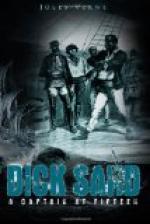“Well!” exclaimed Dick Sand.
“The hole is stopped up by rubbish!” replied Bat, as soon as he could take breath.
“Stopped up!” repeated Tom.
“Yes,” replied Bat. “The water has probably diluted the clay. I have felt around the walls with my hand. There is no longer any hole.”
Dick Sand shook his head. His companions and he were hermetically sequestered in this cone, perhaps submerged by the water.
“If there is no longer any hole,” then said Hercules, “we must make one.”
“Wait,” replied the young novice, stopping Hercules, who, hatchet in hand, was preparing to dive.
Dick Sand reflected for a few moments, and then he said:
“We are going to proceed in another manner. The whole question is to know whether the water covers the ant-hill or not. If we make a small opening at the summit of the cone, we shall find out which it is. But in case the ant-hill should be submerged now, the water would fill it entirely, and we would be lost. Let us feel our way.”
“But quickly,” replied Tom.
In fact, the level continued to rise gradually. There were then six feet of water inside the cone. With the exception of Mrs. Weldon, her son, Cousin Benedict, and Nan, who had taken refuge in the upper cavities, all were immersed to the waist.
Then there was a necessity for quick action, as Dick Sand proposed.
It was one foot above the interior level, consequently seven feet from the ground, that Dick Sand resolved to pierce a hole in the clay wall.
If, by this hole, they were in communication with the outer air, the cone emerges. If, on the contrary, this hole was pierced below the water level outside, the air would be driven inward, and in that case they must stop it up at once, or the water would rise to its orifice. Then they would commence again a foot higher, and so on. If, at last, at the top, they did not yet find the outer air, it was because there was a depth of more than fifteen feet of water in the plain, and that the whole termite village had disappeared under the inundation. Then what chance had the prisoners in the ant-hill to escape the most terrible of deaths, death by slow asphyxia?
Dick Sand knew all that, but he did not lose his presence of mind for a moment. He had closely calculated the consequences of the experiment he wished to try. Besides, to wait longer was not possible. Asphyxia was threatening in this narrow space, reduced every moment, in a medium already saturated with carbonic acid.
The best tool Dick Sand could employ to pierce a hole through the wall was a ramrod furnished with a screw, intended to draw the wadding from a gun. By making it turn rapidly, this screw scooped out the clay like an auger, and the hole was made little by little. Then it would not have a larger diameter than that of the ramrod, but that would be sufficient. The air could come through very well.




